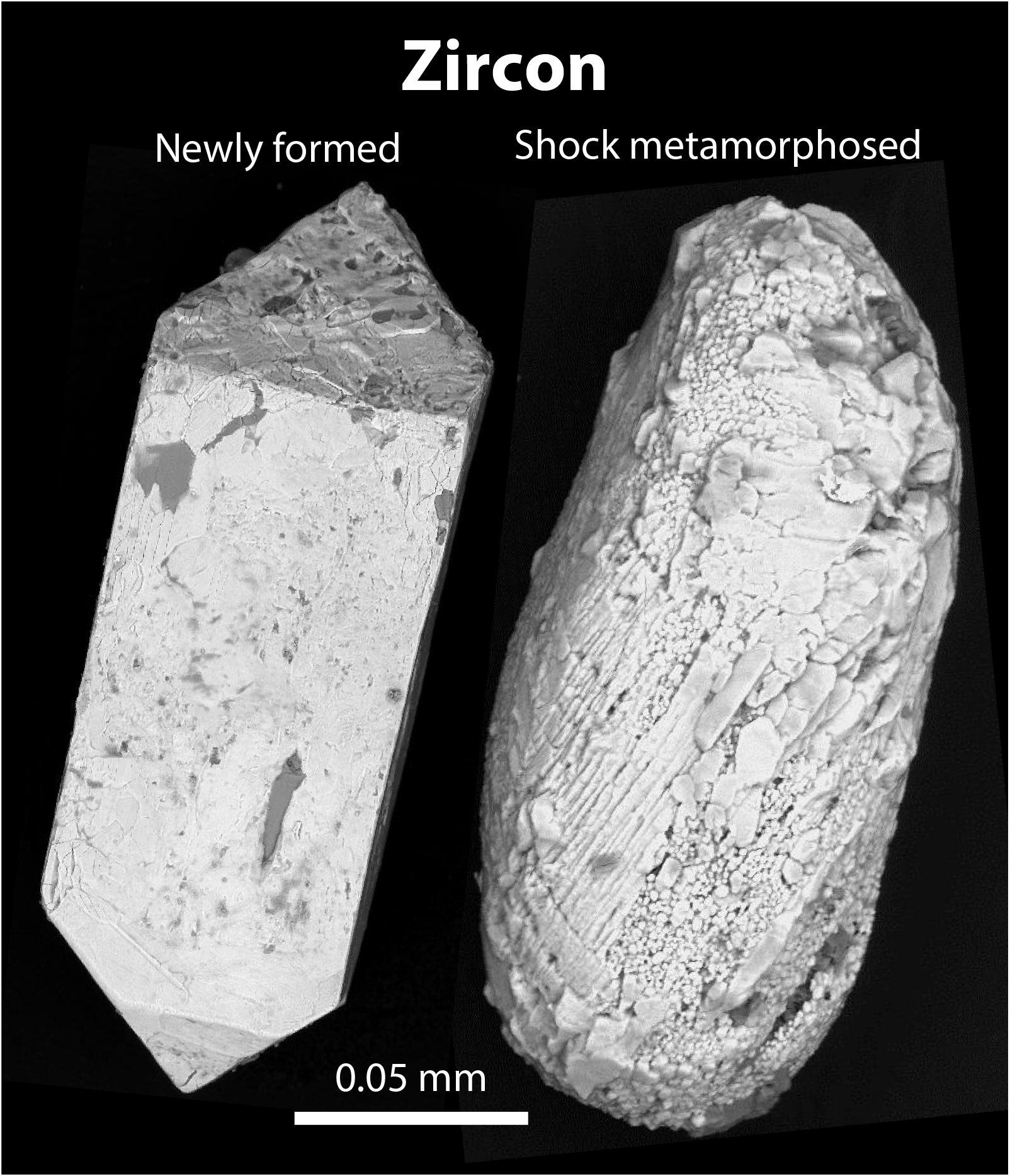Determining the ages of Earth’s impact structures

Scanning electron microscope (SEM) images of the exteriors of two types of zircon used in dating impact structures on Earth. The grain on the left crystallized from a 2–3 km-thick pool of impact melt at the Sudbury impact structure, Canada. The grain on the right is from melt-bearing breccias on top of the melt sheet. This grain crystallized in a granite long before the impact but recrystallized in response to the extreme pressures and temperatures of the impact event and thus also records its age.
Summary
Impact cratering, the collision of asteroids and comets with planetary bodies, is a fundamental geological process that has played a major role in the evolution of Earth’s crust and can trigger climatic perturbations and mass extinctions. However, of the ~200 confirmed impact structures on Earth less than a quarter have well-constrained absolute ages. As such, the full role of impact cratering in Earth’s history remains poorly understood.
In this project we are developing and refined protocols in the absolute dating of impact craters on Earth, and then applying these methods to dating impact structures whose ages have broad scientific interest – such as those that have been proposed as having contributed to mass extinctions.
The mineral zircon is almost ubiquitous in the Earth’s crust and the U–Pb system in zircon is the most commonly applied technique in geochronology. Impact structures are difficult to date with zircon. This is primarily due to the fact that newly formed zircon that crystallized from large bodies of impact melt has only been found at a handful of impact structures (e.g., the Sudbury impact structure, Canada – see left-hand side in figure above). For most impact structures on Earth, researchers have to analyze zircon that already existed in the crust at the time of impact and, as a result of the extreme pressures and temperatures, underwent recrystallization to then record the age of the impact (see right-hand side in figure above). These complex zircon grains often require a special approach including microstructural characterization and high-spatial resolution U–Pb analysis.
We use facilities that are entirely in-house at the museum: rock crushing and mineral separation is done in fully equipped facilities, imaging and microstructural characterization by electron backscatter diffraction (EBSD) analysis is conducted on the state-of-the-art FEI Quanta FEG 650 scanning electron microscope, and high-spatial resolution U–Pb analysis by secondary ion mass spectrometry (SIMS) is conducted on the CAMECA IMS1280 large-geometry ion microprobe at the NordSIMS laboratory.
This project received funding from the European Union’s Horizon 2020 research and innovation programme under the Marie Skłodowska-Curie Individual Fellowship Grant Agreement No. 792030, supporting Kenny. The project was set up between 2018 and 2021 and the established protocol at the museum will continue to be applied and refined in order to test exciting hypotheses regarding the terrestrial impact cratering record for years to come. If you are working on an impact structure that you would like to date or have other ideas for collaboration please get in touch.
Project participants at the museum
External project participants
- Alexander Nemchin, Curtin University, Australia
- Renaud Merle, Uppsala University, Sweden
- Martin Schmieder, Neu-Ulm University of Applied Sciences, Germany
- Teemu Öhman, Arctic Planetary Science Institute, Finland
+ Many other colleagues
Selected Publications
- Kenny, G.G., Mänttäri, I., Schmieder, M., Whitehouse, M.J., Nemchin, A.A., Bellucci, J.J. and Merle, R.E. (2020): Age of the Sääksjärvi impact structure, Finland: reconciling the timing of small impacts in crystalline basement with regional basin development. Journal of the Geological Society, London 177, 1231-1243. https://doi.org/10.1144/jgs2020-034

- Kenny, G.G., Schmieder, M., Whitehouse, M.J., Nemchin, A.A., Morales, L.F.G., Buchner, E., Bellucci, J.J. and Snape, J.F. (2019): A new U-Pb age for shock-recrystallised zircon from the Lappajärvi impact crater, Finland, and implications for the accurate dating of impact events. Geochimica et Cosmochimica Acta 245, 479-494. https://doi.org/10.1016/j.gca.2018.11.021



